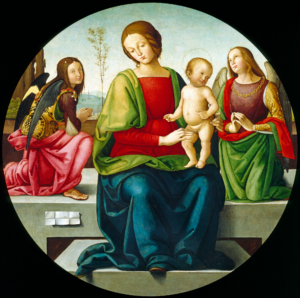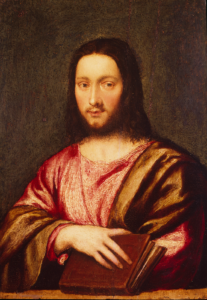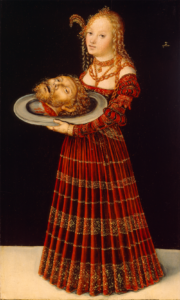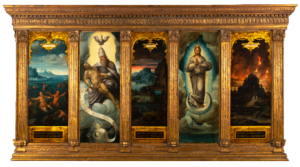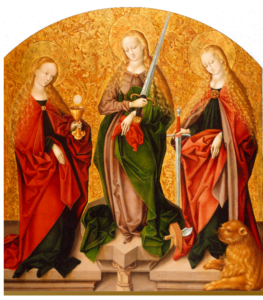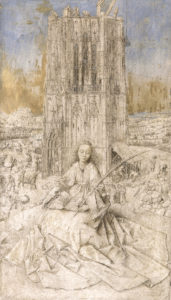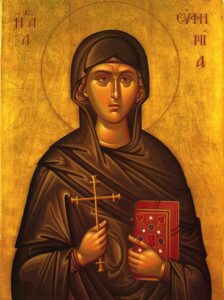While this artist’s paintings are well represented in Spain, rarely is he found outside his native country. M&G’s Pentecost is considered the finest example of Juan de Juanes’ work in America.
Tag Archives: Renaissance art
In this lovely painting, Ambrosius Benson captures the innovative spirit of the Renaissance and Reformation painters.
Madonna and Child with Angels
Tempera and oil on panel
Master of the Greenville Tondo
Umbrian, active late 15th century
This mystery painting was once attributed to the young Umbrian, Raphael as possibly one of his early works (Giuseppe Fiocco, 1937), which could “aid in the studies of the formation of Raphael’s personality” (Mario Salmi). Then, it was suggested as characteristic of Raphael’s teacher in Umbria, Pietro Vannucci, called Perugino (William Suida, 1941 and Wilhelm von Bode, 1921). But it was the great historian Federico Zeri in 1959 and later followed by Everett Fahy, former Metropolitan Museum of Art curator and Director of the Frick, who suggested a different old master entirely.
This tondo (Italian for “round”) is puzzling, but understanding the cultural context of patronage, traditional artistic training, and the workshop setting can help explain some of the mystery.
In the Middle Ages through the early Renaissance, workshop practice was the only common form of artistic instruction in Italy beginning with the religious orders, monasteries, and convents. The Trades (sculptor, mason, architect) were taught from father to son or from an older family member to a younger. Formal apprenticeships emerged in the 13th century in the context of the craft guild system when workshop or bound apprenticeship became a fully regulated system for lay artists. Then, during the 15th century, the dislike for the guild system’s restrictions and process led to an adapted concept of artistic training, called the Academy. The specific training process for artists is further developed in the article about M&G’s painting, A Sibyl by female Old Master, Ginevra Cantofoli.
Throughout all of these training methods to become a master of one’s own workshop, imitation was the most important component of artistic training. Master painters employed a workshop of assistants to copy or paint in his style and to help meet the incoming demand of commissions by patrons. These points are critical to understanding why it is difficult to attribute a specific artistic personality to today’s enduring Old Master paintings. Besides, most painters well into the late 1400s and early 1500s did not autograph their finished works, and finding the original documents commissioning paintings can be challenging.
However, when the artist is unknown, yet there is an entire group of works that look to be by the same master’s hand, the experts (as in this case) will suggest a pseudonym—create a name for the artist after the place or location where his best or most representative work resides. Zeri and Fahy chose M&G’s painting as the namesake for the painter, “The Master of the Greenville Tondo,” meaning this tondo in Greenville, SC.
According to historian Carrie Baker, this painter, subject, and style reflect the “prevailing visual tastes of the period.” Workshop practice utilized multiple assistants and collaborative work to fill commissions that looked like the master’s hand. The assistants were all skilled artisans but working for the key master. Not knowing the assistants’ names isn’t an issue as this was their occupation: to reproduce works at the request of clients in the consistent style of the master to meet customer expectations. Today, we can photograph and print our favorite originals, but then artists could only copy and repeat. Works like M&G’s Madonna and Child with Angels reflect a popular subject and shape of the period, and providing paintings like M&G’s at a client’s request was the master’s way of “positioning . . . his workshop at an economic advantage.”
Many of the masters and their assistants were truly “Renaissance” men—able to tackle the design of many things, not just paintings but manuscripts, reliquary, sculpture, fabrics, architectural features, etc. The anonymous artist as Baker notes, “was probably an active participant of a working-class system of many trades.” The artist is unknown, but by comparing similar characteristics, experts have connected at least 32 works as having come from this same artist’s hand found in places including Pancole, Italy, the Museum of Fine Arts, St. Petersburg in Florida, Princeton University Art Museum in New Jersey, the Walters Art Museum in Baltimore, and the Estensi Gallery in Modena, Italy.
Regardless of this painting and many others not being attributed to a specific, known personality—such as a respected influencer like Perugino or a major name of the Renaissance like Raphael, this master’s work was just as valuable in shaping Umbria’s artistic identity. And, more than that, our painting is shaping the estimation of our own community through the designation “Master of the Greenville Tondo”—bringing honor and recognition to the city of Greenville throughout the world where other works by this unknown master are displayed.
Erin R. Jones, Executive Director
Published 2025
In this altarpiece featuring the Madonna and Christ child, the artist includes several details to embellish the scene, including a child playing a lute. Learn more about this popular Renaissance instrument HERE.
Christ the Redeemer
Oil on panel, c. 1545
Paris Bordone
Venetian, 1500-1571
Museums are filled with works of art of all shapes and sizes. Of course, the large paintings immediately grab a viewer’s attention. However, it is sometimes the small pieces that bring viewers in close and create intimate connections. One of these examples from the Museum & Gallery is a work called Christ the Redeemer. It is a half-length portrait of Christ holding a book, and with its frame it is only around 18 inches by 15 inches. Despite its somewhat simple subject matter and small stature, this painting draws you in and raises questions.
One question woven into the work is the identification of the artist. Various art historians confirm its sixteenth-century Venetian origins because of its color palette and brushwork. When the painting originally became part of the Museum collection in 1954, the artist attached to it was the Venetian Renaissance master Titian. Regarded by his contemporaries as “The Sun Amidst Small Stars,” Titian had a successful career throughout his life and his studio became one of the most influential of the Italian Renaissance. There are specific similarities between Titian’s other portraits of Christ and this Christ the Redeemer such as facial features, the treatment of the hands, as well as previous miniatures created by Titian—which seem to confirm the master’s authorship. However, more recent art historians claim that while the panel is certainly Titianesque, the more likely artist is another Venetian painter, Paris Bordone. Bordone studied under Titian and emulated the master’s style so well that many of Bordone’s works have been misattributed to Titian’s hand. He may not have had as glittering a career as Titian, but Bordone was a successful painter, earning respect and fame during his lifetime.
Another question is the iconography of the painting. The portrait of Christ with a book is not an uncommon one. It reflects the words from John 1:1, “In the beginning was the Word, and the Word was with God, and the Word was God.” Since Early Christian art, Christ has been shown either enthroned in majesty or surrounded by various saints holding a book, which is more than likely the Gospels. What becomes interesting is this iconography continues in Eastern Orthodox art, but becomes rare in post-Medieval Western art. One reason Bordone may have included this iconography is because it was similar to another kind of portrait—a scholar. Portraits of scholarly gentlemen or philosophers were common across Italy. M&G includes an example of these portraits with Giambattista Tiepolo’s A Philosopher Holding a Book. Using a familiar portrait pose, viewers could relate to Christ in the context of the ultimate Rabbi and teacher.
Another reason Bordone may have chosen this pose and iconography is because of its size and purpose. Less than two feet on each side, this painting is a perfect example of a cabinet painting. From the fifteenth century on, wealthy patrons would purchase these small, detailed paintings to hang in small, intimate spaces in their vast homes. These spaces, called cabinets, functioned as small offices or sitting rooms. Because of its size, the cabinet painting draws the viewer in and creates an intimate connection. Knowing this, it is understandable why Bordone may have created Christ in such a pose. It allows the viewer an opportunity to sit one-on-one with the Master Rabbi.
No matter the reasoning of the iconography or even which artist created the work, Christ the Redeemer is an intriguing painting. Like its original purpose, the small panel captivates the viewer. Maybe it will also cause the viewer to ask questions. Maybe it will draw the viewer closer to Christ as the ultimate teacher and incarnate Word in flesh.
KC Christmas Beach, M&G summer educator
Published 2024
Scenes from the Apocalypse
Oil on panel
Unknown French, mid-16th century
These M&G panels are painted sections from a winged altarpiece, positioned on, above, or behind the church’s altar. The wings or hinged doors would be opened for liturgical feasts and events. When the wings were closed, the side facing the audience was often painted in monochrome colors depicting various saints’ lives; as the wings were opened, the interior (including the other side of the doors) revealed more colorful pictures with a large feature painting in the center.
The Scenes from the Apocalypse by an unknown 16th-century French artist illustrates the medieval tradition of the Signs of the Apocalypse (drawn from Mark 13 and Revelation). These five separate panels were once joined in a single winged altarpiece with a total of fourteen or fifteen panels detailing the Signs and with the central interior panel possibly featuring the Last Judgment. Viewing these works from left to right,
- Panel 1 is the Third Sign: sea monsters that ravage the seas.
- Panel 2 is the reverse of Panel 1, being once united as a single panel.
- Panel 3 is the Second Sign: the seas disappearing into the earth.
- Panel 4 is the reverse of Panel 5, being once united as a single panel.
- Panel 5 is the Fourth Sign: the burning of the seas and rivers.
Two ideas are fundamental to understanding this altarpiece. First, these panels illustrate the Word of God. According to Pope Gregory the Great (lived c.540-604), “Illiterate men can contemplate in the lines of a picture what they cannot learn by means of the written word.” Seeing the horrors of the End Times should motivate the viewer to take action to avoid them. These panels become visual conviction.
The Bible portrays man’s sinfulness and presents the atoning work of Christ as the remedy. The panels’ subject matter confronts the viewer with the penalty for sin even before the Last Judgment arrives. Juxtaposing these panels directly with the altar argues that Christ’s sacrificial death on the cross, accepted by God the Father as payment for man’s sin and ratified by Christ’s resurrection from the dead, is man’s rescue from the Apocalypse. In view of these coming events, the physical placement of these panels prompts the viewer to appropriate for himself Christ’s sacrifice.
Secondly, the reverse of the panels—scenes from the lives of Old and New Testament figures—argues for the ability of humans to react properly to the revelation of God’s Word.
- Panel 2 references the conversion of Saul of Tarsus when confronted with the crucified Christ. The presence of the Holy Spirit as the dove and the holding of the slain Christ by God the Father clearly teaches the unity of the Trinity: Saul’s persecution of followers of Christ is persecution of the God that his pharisaical upbringing revered. The panel directly challenges the viewer to answer the Trinity in the same way Saul did: “What would you have me to do, Lord?”
- Panel 4 is the Woman Clothed with the Sun. She is labeled in the Revelation as a sign (12:1), but not included in the medieval list of signs. The artist portrays the Woman just as the Scripture does: “clothed with the sun, and the moon under her feet, and upon her head a crown of twelve stars.” Though many critics identify this Woman as the Virgin Mary, a continued reading of the biblical text—and a careful examination of the panel—shows that this Woman symbolizes the nation Israel whose annihilation the Dragon seeks in the Last Days. Note the dragon tail just visible at the bottom of the panel. The Jewish child is Christ who escapes the Dragon. But “the woman fled into the wilderness, where she hath a place prepared of God that they should feed her there a thousand two hundred and threescore days” (12:6). Mary is not present at the end of the world, but the nation that brought forth the Messiah is. This panel, too, points to Christ as the provision of salvation from destruction of the Last Days.
Like the Pricke of Conscience, a series of stained-glass windows also based on the Signs of the Last Days, M&G’s panels challenge the viewer to consider the Apocalypse from a personal point of view.
Dr. Karen Rowe Jones, M&G board member
Published 2023
Enjoy this series of segments highlighting Picture Books of the Past: Reading Old Master Paintings, a loan exhibition of 60+ works from the M&G collection. The exhibit has traveled to The Museum of the Bible in Washington, D.C. and the Orlando Museum of Art in Florida.
Marietta Robusti’s Allegory of Wisdom is replete with both Christian and mythological symbols. (Following your video viewing click HERE to access the additional information provided on the exhibition’s text panels.)
